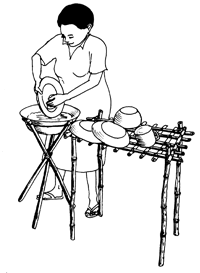Good hygiene in handling food is very important. However, it is also important to make sure that the dishes and utensils used for serving food are clean. If dishes and utensils are washed in dirty, greasy water they will be covered with many microbes. If they are dried with dirty cloths they will collect more microbes.
Use soap for washing dishes and utensils. If water supplies are limited, washing water does not have to be drinking water quality. However, always rinse dishes and utensils with safe water after washing. Avoid drying them with cloths. It is much better to make a simple drying rack so that dishes dry in the sun. Not only is this more hygienic but it saves time!
Wooden, plastic and clay dishes and utensils need particular care in washing. Microbes can remain in cracks and rough surfaces. Enamel and metal containers are easier to clean.
Utensils that are clean and dry should be stored where pests and flies will not spread microbes on them. They can be stored on a drying rack and covered with a cloth. If there is a cupboard available, store them upside-down to stop cockroaches, mice and other pests crawling into them. Utensils should not be left lying on the ground.
Discussion
- Look at a typical plate used for serving food. Can we see microbes on it? How can we tell if it is really clean?
- What methods are used to wash dirty dishes here? Are dishes and utensils always washed with soap and rinsed with clear water?
- Who does the washing of utensils? Are they likely to be aware of good hygiene? How can we help them to understand how microbes can make utensils dirty even if they look clean?
- What kind of cloths are used for drying utensils? Are they clean?
- Are drying racks commonly used? If not, could we try to make one and try it out? What materials are available to make a rack?
- How can we encourage others to make and to use racks?
- How are clean dishes and utensils stored? Are they kept free from pests? How can we make sure that pests do not walk over them while they are being stored?










